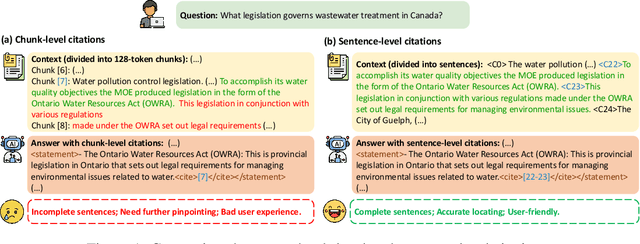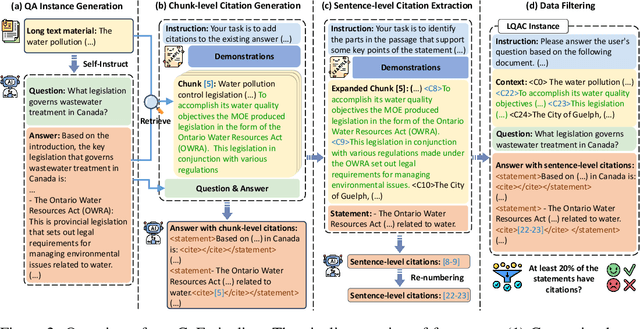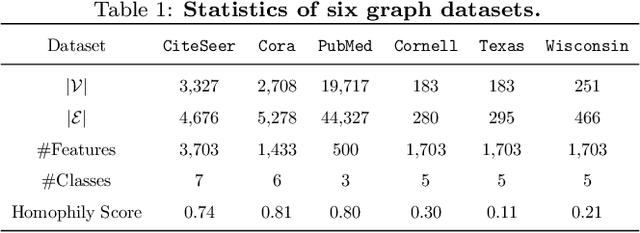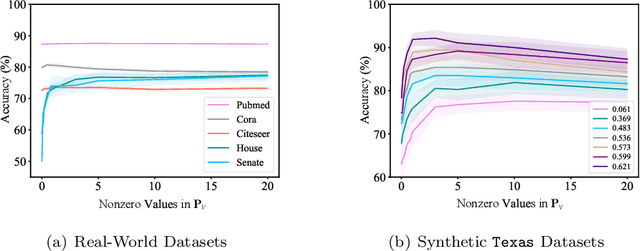Minhao Zou
LongCite: Enabling LLMs to Generate Fine-grained Citations in Long-context QA
Sep 04, 2024



Abstract:Though current long-context large language models (LLMs) have demonstrated impressive capacities in answering user questions based on extensive text, the lack of citations in their responses makes user verification difficult, leading to concerns about their trustworthiness due to their potential hallucinations. In this work, we aim to enable long-context LLMs to generate responses with fine-grained sentence-level citations, improving their faithfulness and verifiability. We first introduce LongBench-Cite, an automated benchmark for assessing current LLMs' performance in Long-Context Question Answering with Citations (LQAC), revealing considerable room for improvement. To this end, we propose CoF (Coarse to Fine), a novel pipeline that utilizes off-the-shelf LLMs to automatically generate long-context QA instances with precise sentence-level citations, and leverage this pipeline to construct LongCite-45k, a large-scale SFT dataset for LQAC. Finally, we train LongCite-8B and LongCite-9B using the LongCite-45k dataset, successfully enabling their generation of accurate responses and fine-grained sentence-level citations in a single output. The evaluation results on LongBench-Cite show that our trained models achieve state-of-the-art citation quality, surpassing advanced proprietary models including GPT-4o.
UniG-Encoder: A Universal Feature Encoder for Graph and Hypergraph Node Classification
Aug 03, 2023



Abstract:Graph and hypergraph representation learning has attracted increasing attention from various research fields. Despite the decent performance and fruitful applications of Graph Neural Networks (GNNs), Hypergraph Neural Networks (HGNNs), and their well-designed variants, on some commonly used benchmark graphs and hypergraphs, they are outperformed by even a simple Multi-Layer Perceptron. This observation motivates a reexamination of the design paradigm of the current GNNs and HGNNs and poses challenges of extracting graph features effectively. In this work, a universal feature encoder for both graph and hypergraph representation learning is designed, called UniG-Encoder. The architecture starts with a forward transformation of the topological relationships of connected nodes into edge or hyperedge features via a normalized projection matrix. The resulting edge/hyperedge features, together with the original node features, are fed into a neural network. The encoded node embeddings are then derived from the reversed transformation, described by the transpose of the projection matrix, of the network's output, which can be further used for tasks such as node classification. The proposed architecture, in contrast to the traditional spectral-based and/or message passing approaches, simultaneously and comprehensively exploits the node features and graph/hypergraph topologies in an efficient and unified manner, covering both heterophilic and homophilic graphs. The designed projection matrix, encoding the graph features, is intuitive and interpretable. Extensive experiments are conducted and demonstrate the superior performance of the proposed framework on twelve representative hypergraph datasets and six real-world graph datasets, compared to the state-of-the-art methods. Our implementation is available online at https://github.com/MinhZou/UniG-Encoder.
 Add to Chrome
Add to Chrome Add to Firefox
Add to Firefox Add to Edge
Add to Edge